This wholegrain millet bread is naturally gluten-free and vegan, it is soft, fluffy, moist, and so easy to make! It is also much cheaper than storebought bread, yet it is squishy, light, and has a delicate crumb. This is the easier version of my no-knead Dutch oven gluten-free bread!
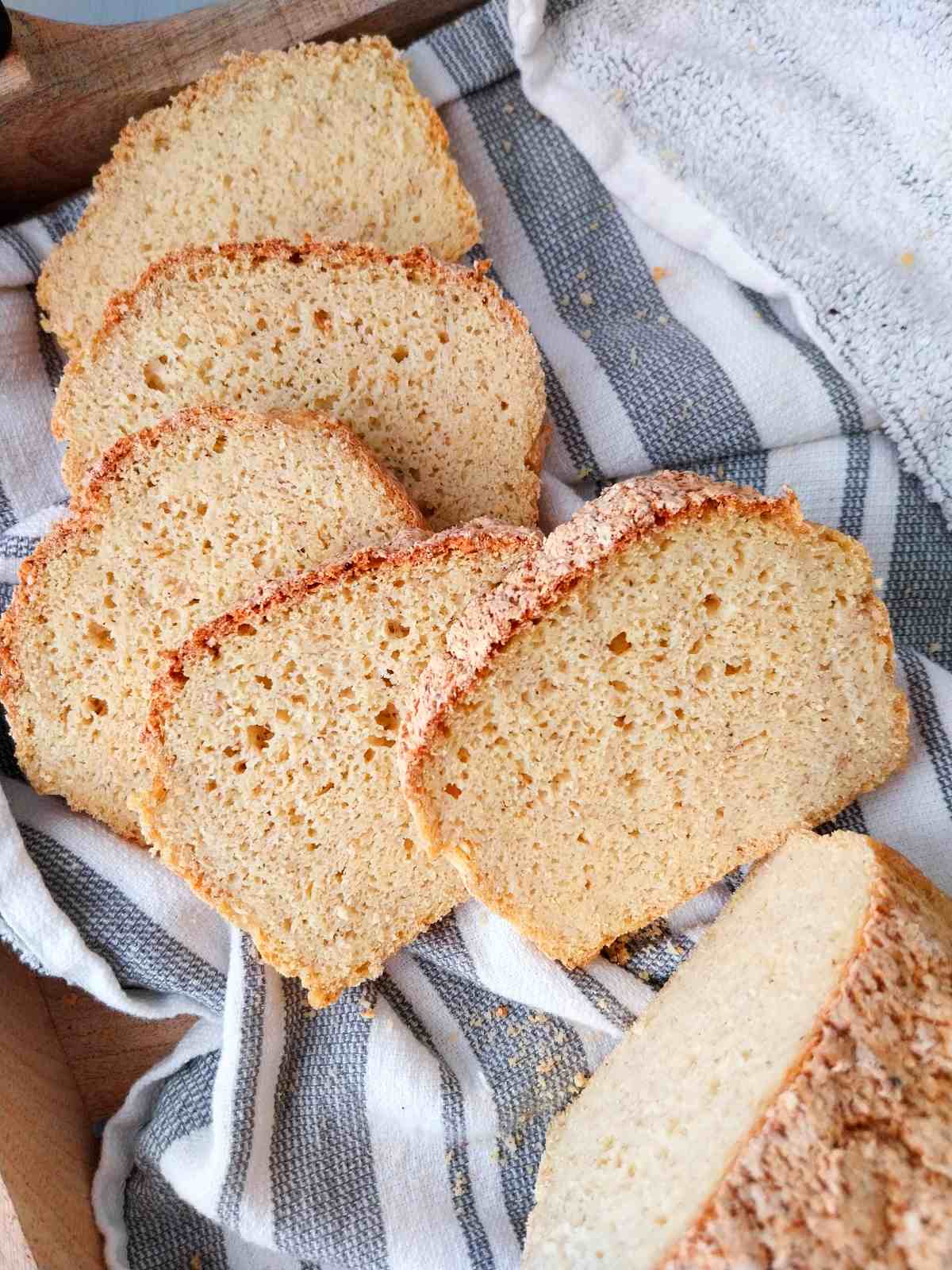
Millet is considered an ancient grain with a low glycemic index and lots of fiber! It is also sometimes called a pseudo-grain or pseudocereal, meaning that it functions like a grain but in fact is a seed. Either way, it is a good source of iron, vitamin B, potassium, calcium, zinc, and magnesium which is a bonus!
Jump to:
Why you will love this recipe
- Calls for millet flour only (no starches, no other flours).
- It's also a naturally vegan recipe (no eggs)
- Quick & easy
- No xanthan gum
More single-flour gluten-free bread recipes:
Ingredients
I wanted to make this recipe as simple and healthy as possible with minimal ingredients, so you will only need millet flour and a few other things. Let's do this!
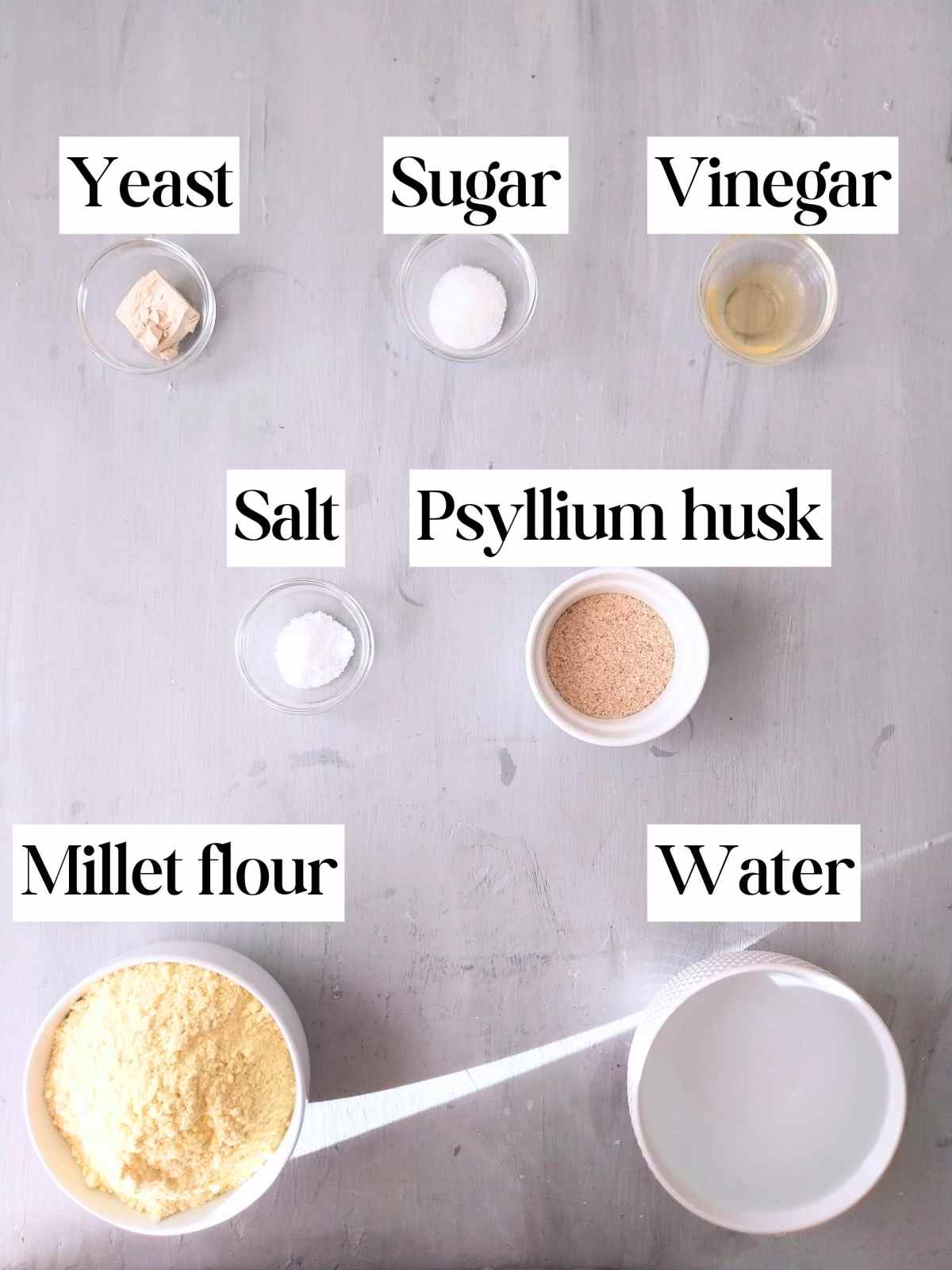
- Millet flour - you can either buy millet flour or make your own at home.
- Psyllium husk - I strongly recommend using whole husks vs. powder.
- Yeast - find the best yeast brand in your area. For me, it's fresh Hungarian yeast (it works wonders) but instant or active dry yeast should also work! Instant and fresh yeast don't require activation and save you time!
- Vinegar - helps yeast by providing an acidic environment. I recommend using apple cider vinegar but any other light or dark vinegar will work.
- Sugar - helps yeast do its work! Don't worry, most of the sugar will get processed by yeast so you won't be consuming it in pure form.
See the recipe card for quantities.
Substitutions
Millet flour - I don't recommend using a different flour because all gluten-free flours absorb liquids differently, so you will need to tweak the ratio of ingredients.
I did test other flours though, so here is a bread with 100% almond flour, 100% buckwheat loaf, and a loaf with white rice flour.
Note: sometimes sorghum and amaranth are called millet, which makes it confusing as to which flour to use. Remember, for this recipe, you can't use either sorghum not amaranth you need to use millet flour (looks yellow-ish).
Psyllium husk - I highly recommend using whole psyllium husk and avoiding substituting it for anything. Neither xanthan gum, not chia seeds, nor flaxseed meal will yield the same results!
Yeast - this is a tricky one. Your yeast might be fresh, yet, not raise your bread. Sometimes the success depends on the manufacturer and the quality of the yeast. So, I'd recommend asking your friends which one works best for them!
You can also try my bread made with wild yeast!
Vinegar - if you can't have vinegar, use the same amount of lemon or lime juice instead.
How to make millet flour at home

You will need:
- A high-speed blender or a coffee grinder (avoid using a food processor, it can only make coarse meal, not flour)
- Hulled millet grains (proso millet)
- Fine-mesh sieve
Place the millet into the blender or grinder and process for a minute or two. Then, sieve the flour into a bowl removing any larger bits that don't go through. That's it!
You can freeze homemade millet flour in a freezer bag and use when ready (no need to defrost).
Instructions
Tip: Make sure your yeast is not expired before proceeding! The bread will turn into a brick if the yeast is inactive.
If you are using active dry yeast:
- Take half of the water and warm it up to about 115F/46C
- Add sugar and yeast then stir
- The yeast should get frothy after about 15 minutes, if it didn't it isn't active!
Step 1
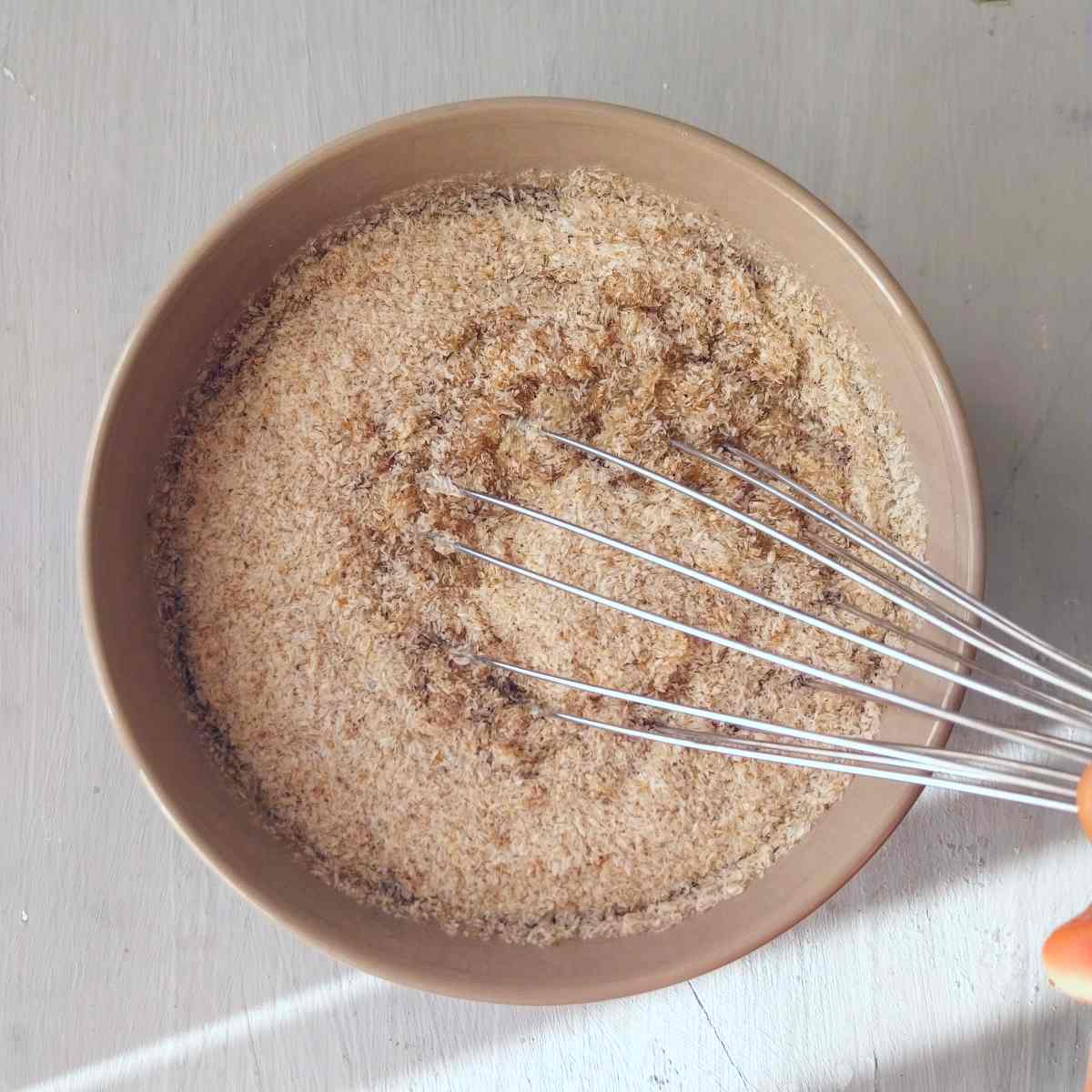
Add water, vinegar, and psyllium husk to a medium bowl and whisk vigorously as soon as psyllium is added.
Set the bowl aside until called for.
Step 2

Mix millet flour, sugar (unless you are using active dry yeast in which case you already used the sugar), salt, and yeast in a large mixing bowl.
Step 3
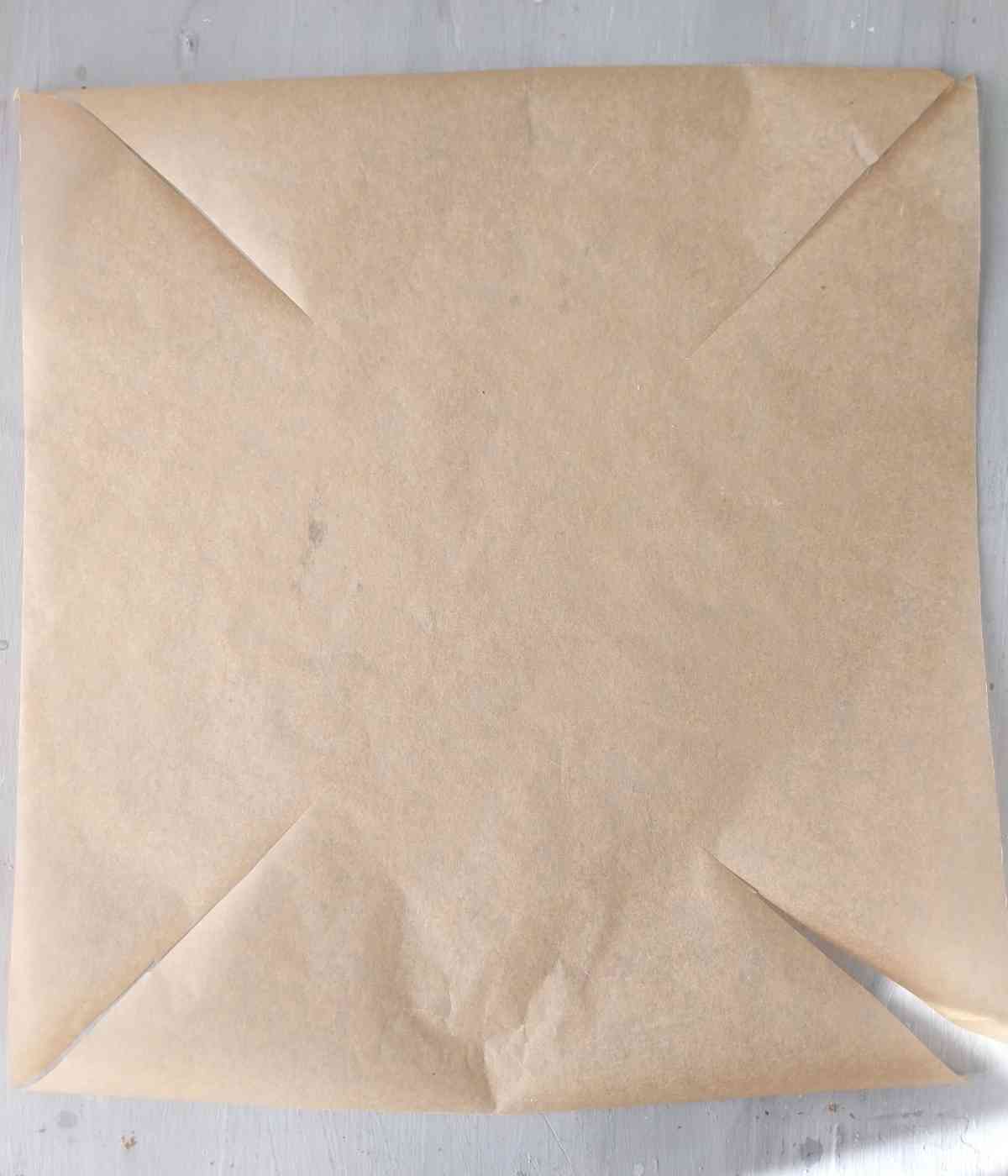
We need to wait for psyllium to hydrate for a few more minutes, and in the meantime, you can prepare the baking pan and paper.
I like to use a 9x5 inch (22.5x12.5 cm) Pullman loaf pan for this bread. You can grease it, spray it, or line it with parchment paper (a safer choice).
To line with parchment, make diagonal cuts on the piece of parchment paper leading from each corner toward the center (½ of the way). This will help you line the pan without wrinkles.
Step 4

Line the loaf pan and use clothespins to hold the paper in place.
Step 5

Check psyllium gel, it should have settled by now!
Step 6
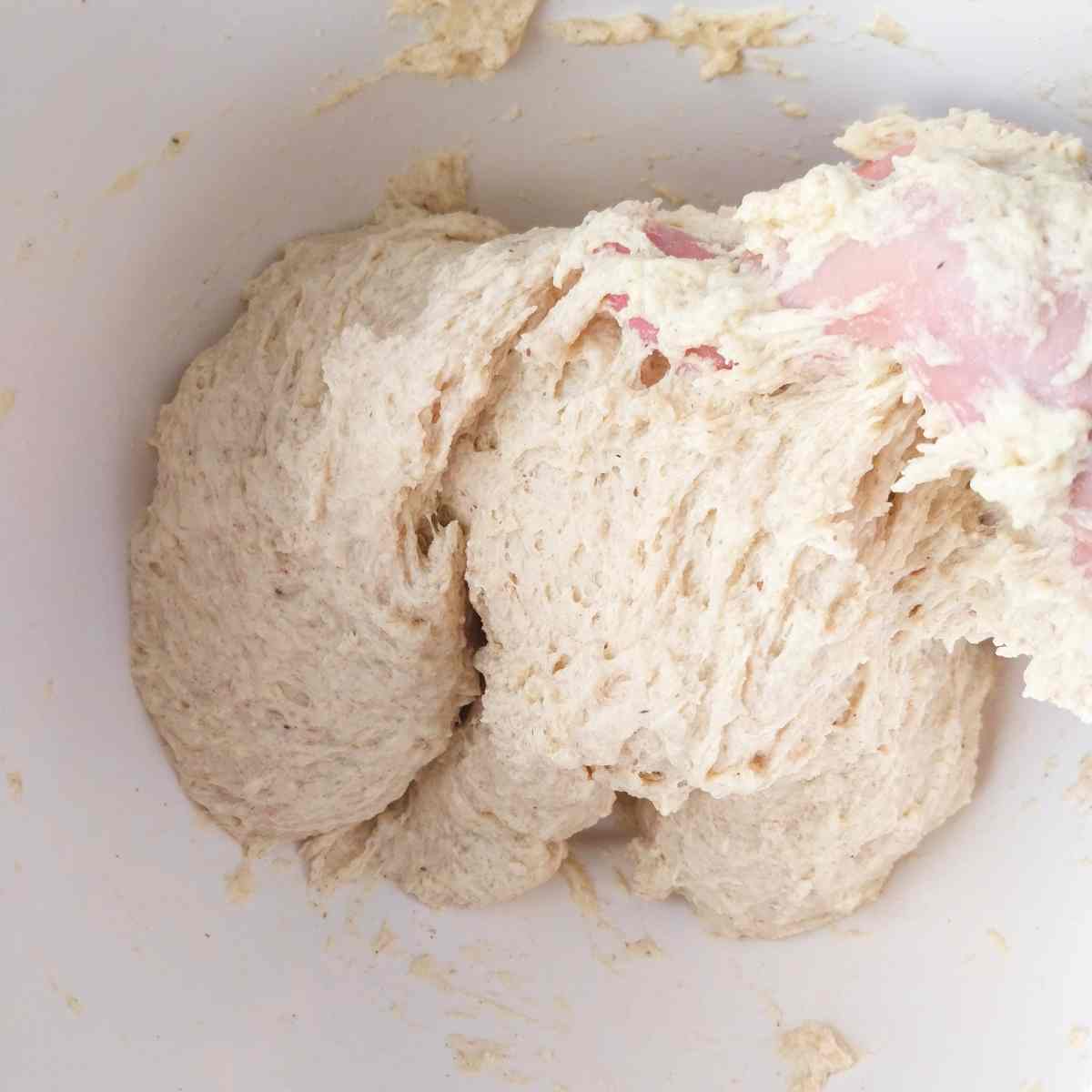
Add psyllium gel to the bowl with dry ingredients and mix by hand until the dough comes together.
Tip: To make extra smooth bread, use an electric mixer with the dough hook and knead for 5-10 minutes.
The dough will be sticky but not watery.
Step 7

Wash your hands, and while they are still wet, take the dough and transfer it to the baking pan.
Smooth the top of the dough with a spatula and cover the pan with a kitchen towel (no need to use a damp one).
Let the dough rise in a draft-free area until the bread comes to the top of the pan (or a little below the rim), not higher, or it will collapse during baking!
Step 8

Bake for 90 minutes (1.5 hours) at 350F/175C. You don't need to cover the bread through baking as it doesn't brown much.
Don't use convection (fan)! If you use the fan setting, the bread will dry out on the outside while being gooey on the inside, yuck!
All you need is the radiant heat of a conventional oven.
Take the bread out of the pan, carefully peel off the paper, and transfer the loaf to the cooling rack. Cool until the bread is no longer warm to the touch!
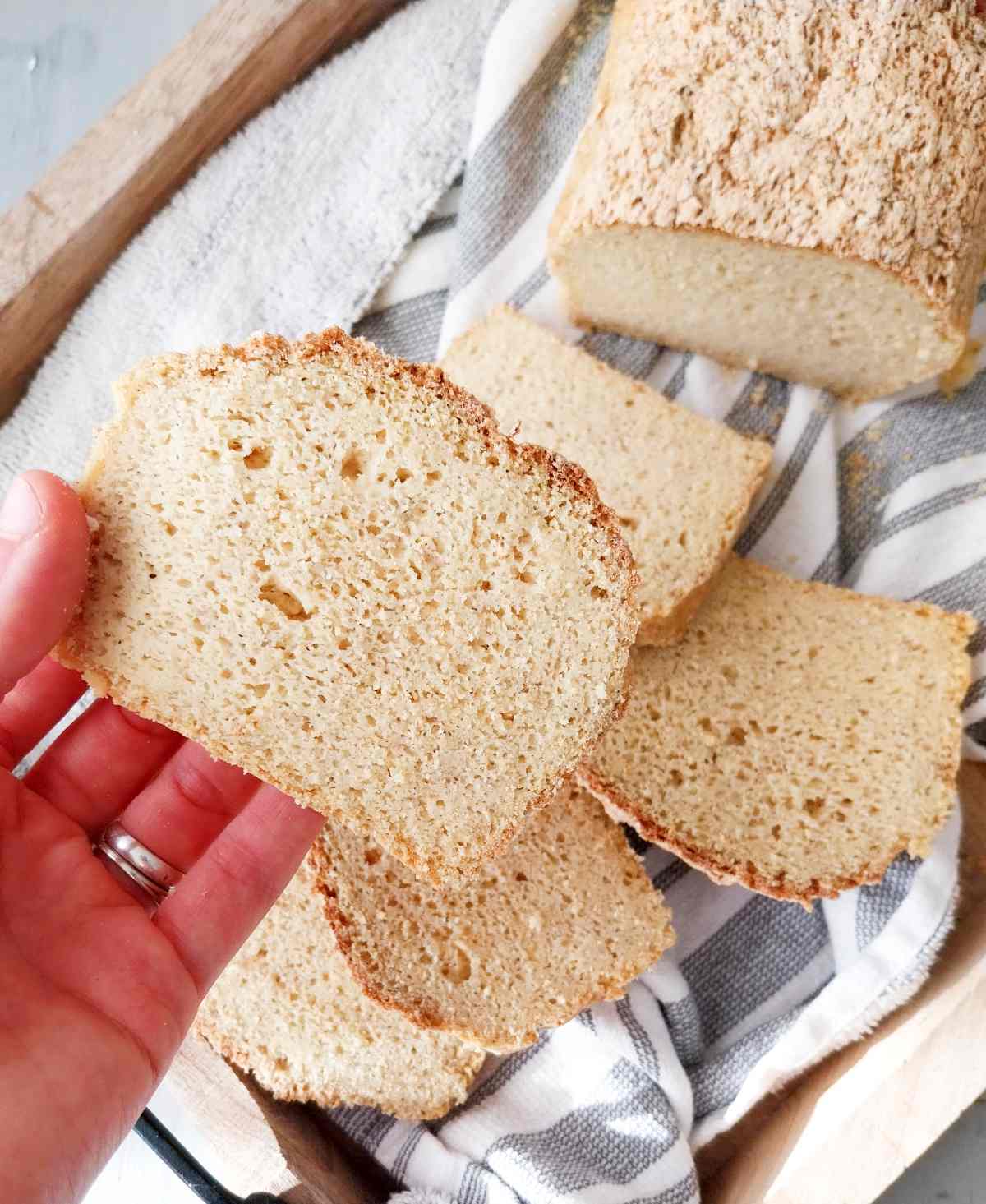
Hint: you won't regret getting a cooling rack for your bread because it provides airflow on all sides including the bottom of the loaf (which is important to avoid sogginess).
Storage & Freezing
Store the bread in a bread box or bag at room temperature for 3-4 days. The bread will start drying out a bit by day 4, so I recommend freezing it if you aren't planning on eating it soon.
To freeze:
- Slice the bread with a serrated bread knife;
- Arrange the sliced on a tray and place into the freezer;
- After 30 minutes transfer the slices to an air-tight container or a sealed freezer bag and keep for up to 3 months.
To defrost:
- Pop the pieces into the microwave for 30-60 seconds;
OR
- Reheat in the oven at 350F/175C for 5 minutes.
What does millet bread taste like?
Millet flour tends to make baked goods slightly bitter if used in excess. Since this recipe uses 100% millet flour, the bread has a slightly bitter taste if eaten on its own, so I highly recommend making a sandwich with it or eating it with a sweet spread.
You can make an avocado grilled cheese, BLT sandwich, French toast, peanut butter and jelly sandwich, or simply eat it with butter and a slather of delicious elderberry jam.
Otherwise, the texture of this bread is soft and fluffy thanks to psyllium husk! And the best part is that it states this way for days.
Variations
You can experiment with different add-ins to flavor up the experience! You can add:
- Dried herbs (thyme, basil, oregano, or sage);
- Spices (cumin, garlic, and/or onion powder);
- Seeds (sunflower, whole flax seeds, sesame seeds, pumpkin seeds);
- Cheese to the top of the bread;
- Olives and sundried tomatoes
Make it sweet by reducing salt and adding bananas or pumpkin along with some sugar!
Expert tips
- Don't let the dough rise above the bread pan rim or it will collapse during baking!
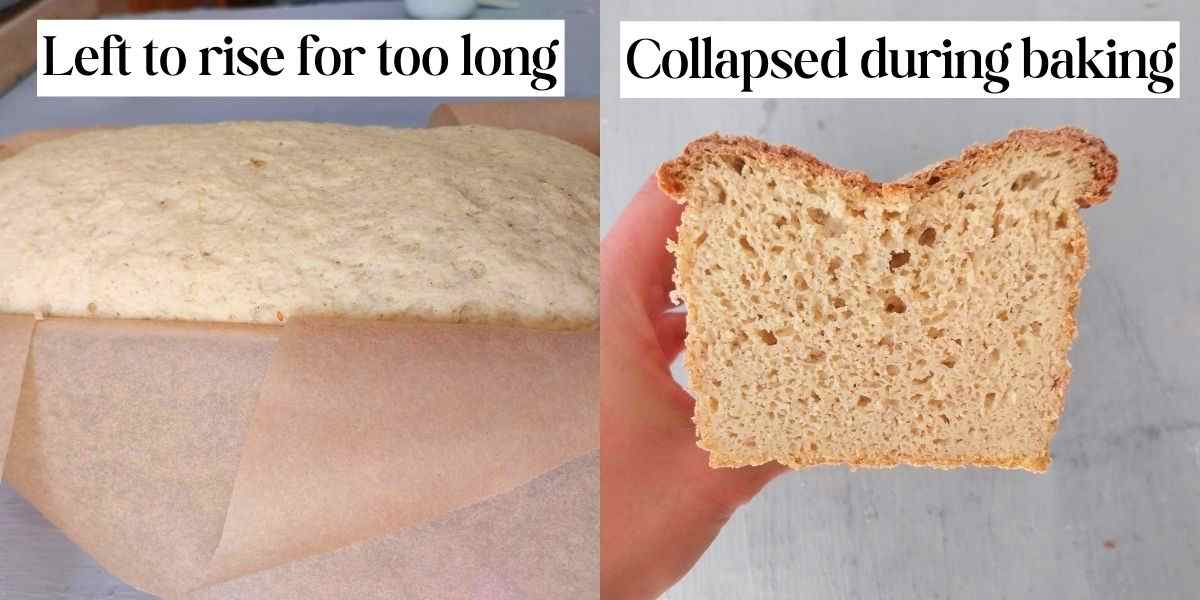
- Measure flour by weight using a digital kitchen scale. I can't overemphasize the importance of precision when it comes to gluten-free bread!
- Use a 9x5-inch (22.5x12.5 cm) Pullman loaf pan for the best results. You can also use a silicone bread pan if you prefer. If you want this bread to yield square slices, use a Pullman loaf pan with a lid.
FAQ
- Not baking long enough (or using convection)
- Not waiting for psyllium to form into a gel
- Your oven might run hot or cold (use an oven thermometer)
According to WebMD, millet is low in simple carbs and high in complex carbs. It takes longer for your body to digest millet bread, hence this bread has a lower glycemic index which means it won't spike your sugar levels after eating!
Millet is low FODMAP, and since this bread barely has anything in it other than millet flour, it is low FODMAP as well.
Millet flour is naturally gluten-free, so it is suitable for people with Celiac disease and gluten or lactose intolerances.
Other gluten-free bread recipes
Looking for other recipes like this? Try these:
What goes with this bread
These are my favorite dishes to serve with [this recipe]:
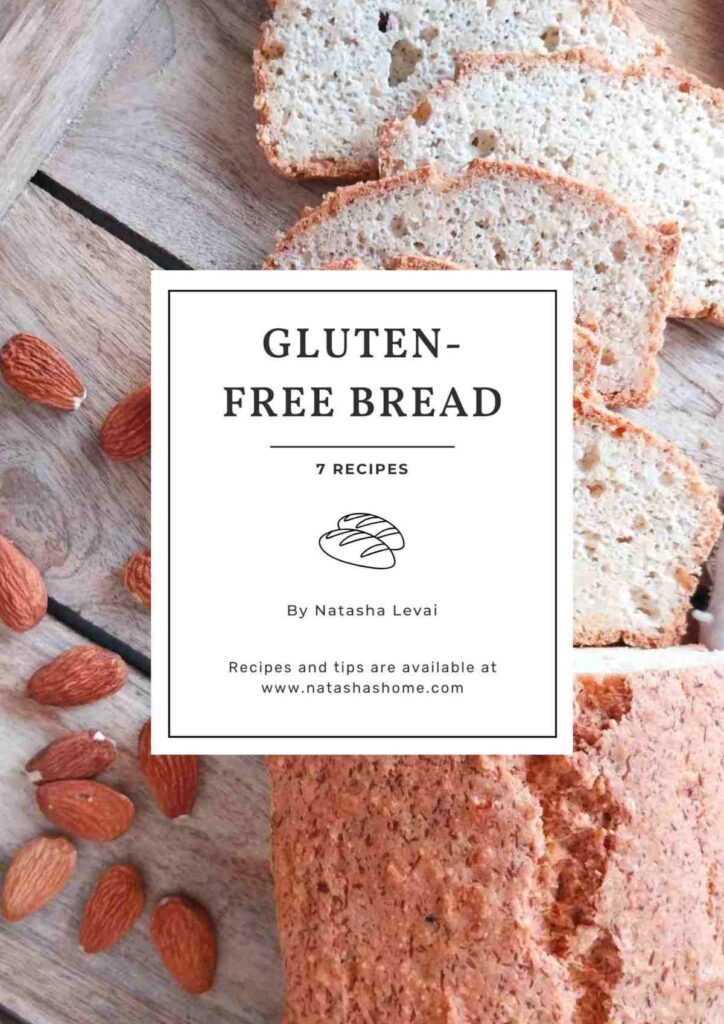
Get my new
Gluten-Free Bread Recipes eBook
The top 7 recipes of 2024!
📖 Recipe

Easy 100% Millet Bread (No Egg)
Ingredients
- 26 grams (3tbsp+2tsp) whole psyllium husk I don't recommend using powder, see my psyllium husk guide to know the difference
- 2½ cups (565g) water if you are using active dry yeast, use some of the water to activate the yeast
- 7 grams (1 packet) instant yeast if using active dry yeast, you will need to activate it before baking
- 2 teaspoon sugar for the yeast
- 1 tablespoon (16g) apple cider vinegar for the yeast
- 400 grams (2¾cups) millet flour not sorghum or amaranth, those are different
- 7-10 grams (1-2 tsp) salt adjust to taste
Instructions
- Tip: Make sure your yeast is not expired before proceeding! The bread will turn into a brick if the yeast is inactive.
- If you are using active dry yeast:- Take half of the water and warm it up to about 115F/46C- Add sugar and yeast then stir- The yeast should get frothy after about 15 minutes, if it didn't it isn't active!
- Add water, vinegar, and psyllium husk to a medium bowl and whisk vigorously as soon as psyllium is added. Set the bowl aside until called for.
- Mix millet flour, sugar (unless you are using active dry yeast in which case you already used the sugar), salt, and yeast in a large mixing bowl.
- We need to wait for psyllium to hydrate for a few more minutes, and in the meantime, you can prepare the baking pan and paper.I like to use a 9x5 inch (22.5x12.5 cm) Pullman loaf pan for this bread. You can grease it, spray it, or line it with parchment paper (a safer choice). To line with parchment, make diagonal cuts on the piece of parchment paper leading from each corner toward the center (½ of the way). This will help you line the pan without wrinkles.
- Line the loaf pan and use clothespins to hold the paper in place.
- Check psyllium gel, it should have settled by now!
- Add psyllium gel to the bowl with dry ingredients and mix by hand until the dough comes together. Tip: To make extra smooth bread, use an electric mixer with the dough hook and knead for 5-10 minutes. The dough will be sticky but not watery.
- Wash your hands, and while they are still wet, take the dough and transfer it to the baking pan. Smooth the top of the dough with a spatula and cover the pan with a kitchen towel (no need to use a damp one). Let the dough rise in a draft-free area until the bread comes to the top of the pan (or a little below the rim), not higher, or it will collapse during baking!
- Bake for 90 minutes (1.5 hours) at 350F/175C. You don't need to cover the bread through baking as it doesn't brown much. Don't use convection (fan)! If you use the fan setting, the bread will dry out on the outside while being gooey on the inside, yuck!All you need is the radiant heat of a conventional oven. Take the bread out of the pan, carefully peel off the paper, and transfer the loaf to the cooling rack. Cool until the bread is no longer warm to the touch!
Notes
- Slice the bread with a serrated bread knife;
- Arrange the sliced on a tray and place into the freezer;
- After 30 minutes transfer the slices to an air-tight container or a sealed freezer bag and keep for up to 3 months.

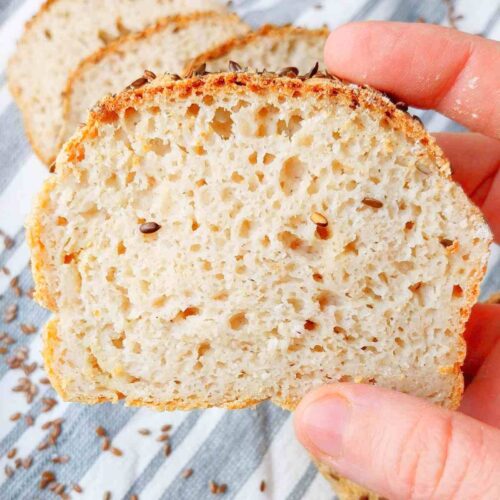
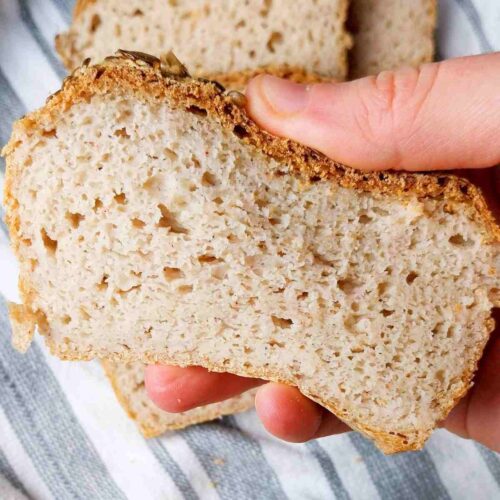
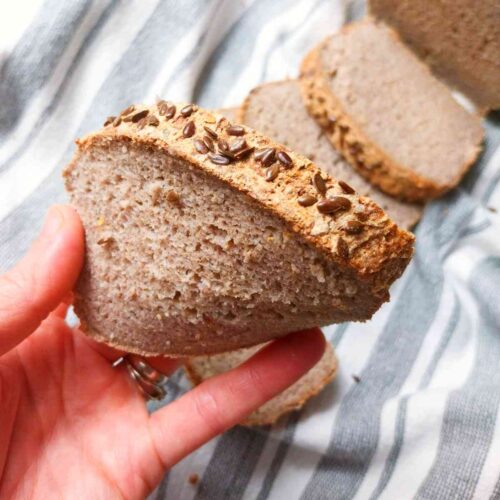
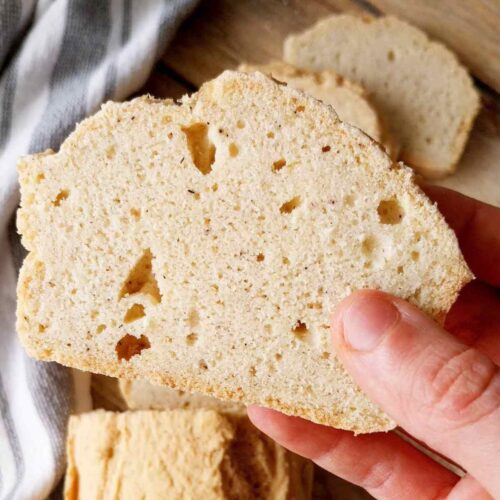
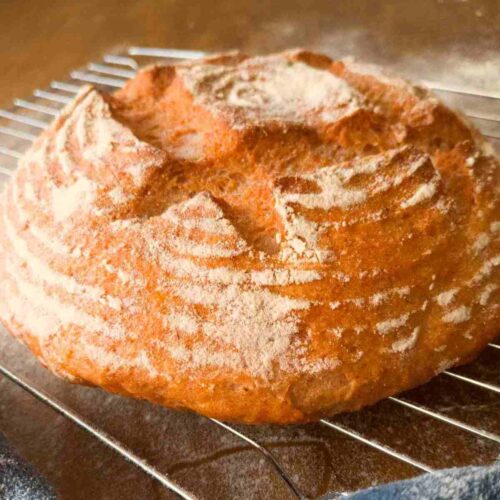
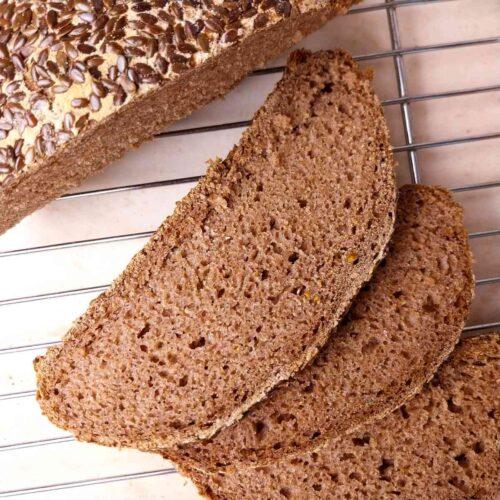
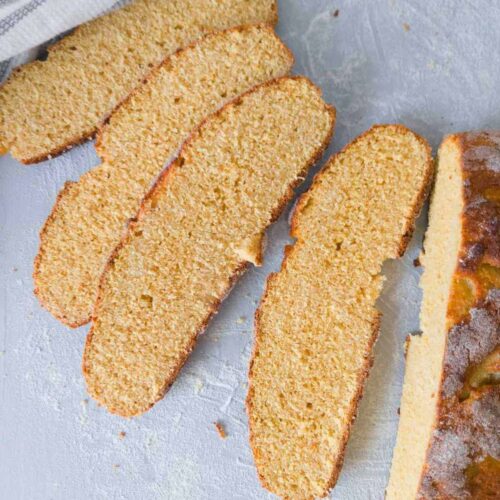
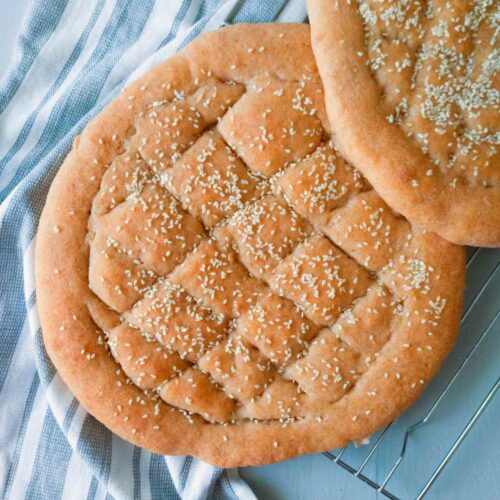
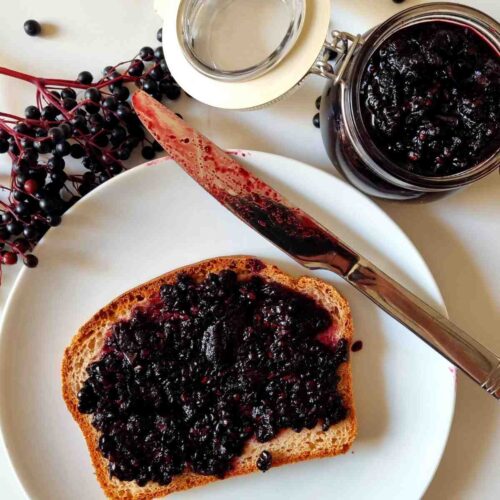
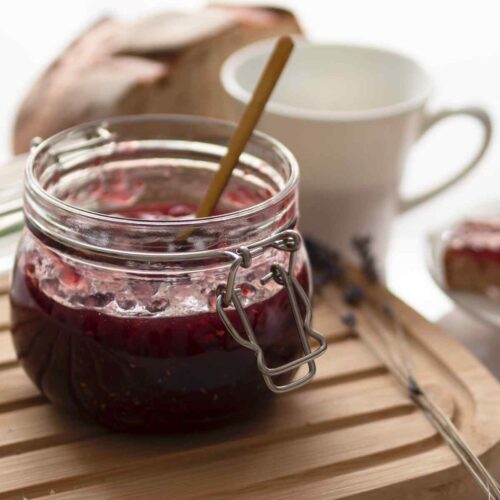
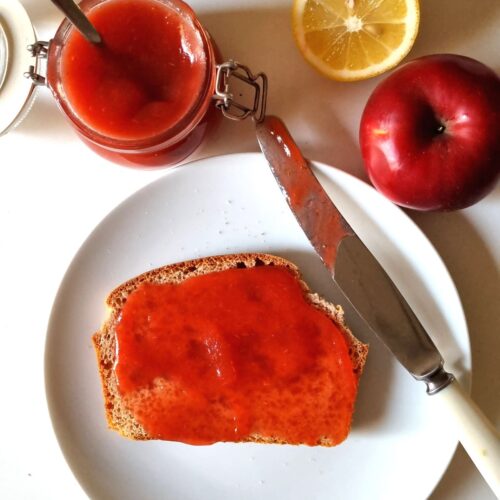

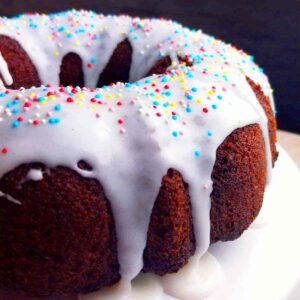
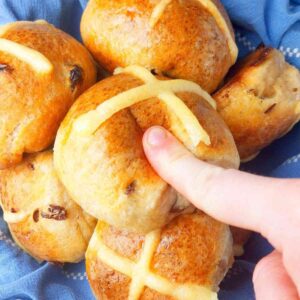
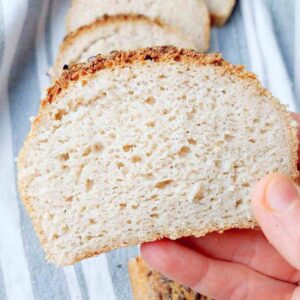
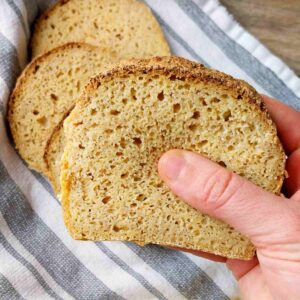
Ani
I made a loaf yesterday and it was delicious. I am familiar with psyllium husk and I know it makes a huge difference in the gluten free bread. I wander if you ever tried a similar recipe with oat flour? For me oat flour is the closest in flavor with regular flour and I been using it in my mix of gluten free flours but I never found a good recipe only with oat flour. Thank you very much for the recipe!
Natasha Levai
Hi Ani! I don't yet have a bread recipe using oat flour only, but I might look into it in the next few weeks!
Mariana
Hi Natasha, I've made this lovely loaf and few times and love it! thanks!
However, a query. You say in the 3rd step I think it is to "Mix millet flour, sugar (unless you are using active dry yeast in which case you already used the sugar), salt, and yeast in a large mixing bowl"
I've already mixed the sugar and active dried yeast in 1/2 water, so why are you saying to mix more yeast in with the millet and salt? Its a bit confusing.
I just mix the salt and flour into the psyllium mix after it has gelled and it seems to work.
Natasha Levai
Thank you for the note! You are right, you can just add the yeast mixture once you add the wet ingredient to the flour mix. It must be a typo in the recipe 🙂
Cauvigne
Turned out great. Very soft and nice chew consistency. I got lucky because my instant yeast expired in May 2022 but still did the job.
Natasha Levai
Woohoo! I am happy it worked for you 🙂
HP
Has anyone converted this recipe for bread machine?
Chloe
Hi
I struggle with sugar and wondered if a sugar substitute might work…such a xylitol?
Thanks,
Chloe
Natasha Levai
You could try honey or maple syrup, not sure about xylitol! Never tried it, but you can give it a go. Sugar is only there to help the bacteria, so technically you could leave it out without drastic changes to the recipe 🙂
Erica Senchuk
Did everyone really bake this little loaf for 90 minutes!?!
Michelle
this bread was quite bitter
Natasha Levai
Yes, millet flour has a bitter flavor on its own. However, if you eat this bread in a sandwich the bitter flavor should not be noticed as much!
STEVE J GIANNETTA
we really enjoyed the bread. We have been on a lectin free diet for a couple of months and yearned for some bread.
a couple of attempts have failed, but this turned out!!
we used the psyllium husk power and used 85 percent as instructed
the only issue was a large air pocket in the bread
any suggestions would be appreciated
thanks for recipe
steve and Michelle
Natasha Levai
Are the large pockets in between the top crust and the crumb or are they evenly distributed through the bread?
STEVE J GIANNETTA
The large pocket is between the top crust and the rest of it. It's like a big tunnel.
Natasha Levai
That is a sign that the loaf is overproofed (was left rising for too long). In this case the dough cannot hold its structure and falls down creating a large pocket on the top as well as a gummy bottom.
STEVE J GIANNETTA
yes , I let rise to nearly the top of pan but it took about 40 minutes. which I thought was long,
thank u
Christina
I made this a few weeks ago and enjoyed it as well as my two co-workers. I’d like to make two loaves. I only have one Pullman pan, can I bake this in a glass loaf pan?
Natasha Levai
Hi Christina! Glass is not the best for baking bread, it doesn't transfer heat as much which means your bread will most likely be underbaked and gummy. You can use any other pan though!